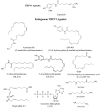TRPV1: A Potential Drug Target for Treating Various Diseases
- PMID: 24861977
- PMCID: PMC4092862
- DOI: 10.3390/cells3020517
TRPV1: A Potential Drug Target for Treating Various Diseases
Abstract
Transient receptor potential vanilloid 1 (TRPV1) is an ion channel present on sensory neurons which is activated by heat, protons, capsaicin and a variety of endogenous lipids termed endovanilloids. As such, TRPV1 serves as a multimodal sensor of noxious stimuli which could trigger counteractive measures to avoid pain and injury. Activation of TRPV1 has been linked to chronic inflammatory pain conditions and peripheral neuropathy, as observed in diabetes. Expression of TRPV1 is also observed in non-neuronal sites such as the epithelium of bladder and lungs and in hair cells of the cochlea. At these sites, activation of TRPV1 has been implicated in the pathophysiology of diseases such as cystitis, asthma and hearing loss. Therefore, drugs which could modulate TRPV1 channel activity could be useful for the treatment of conditions ranging from chronic pain to hearing loss. This review describes the roles of TRPV1 in the normal physiology and pathophysiology of selected organs of the body and highlights how drugs targeting this channel could be important clinically.
Figures
Similar articles
-
Medicinal Chemistry, Pharmacology, and Clinical Implications of TRPV1 Receptor Antagonists.Med Res Rev. 2017 Jul;37(4):936-983. doi: 10.1002/med.21427. Epub 2016 Dec 15. Med Res Rev. 2017. PMID: 27976413 Review.
-
Beyond Neuronal Heat Sensing: Diversity of TRPV1 Heat-Capsaicin Receptor-Channel Functions.Front Cell Neurosci. 2021 Feb 5;14:612480. doi: 10.3389/fncel.2020.612480. eCollection 2020. Front Cell Neurosci. 2021. PMID: 33613196 Free PMC article. Review.
-
Endogenous and Exogenous Vanilloids Evoke Disparate TRPV1 Activation to Produce Distinct Neuronal Responses.Front Pharmacol. 2020 Jun 12;11:903. doi: 10.3389/fphar.2020.00903. eCollection 2020. Front Pharmacol. 2020. PMID: 32595512 Free PMC article.
-
Endovanilloids. Putative endogenous ligands of transient receptor potential vanilloid 1 channels.Eur J Biochem. 2004 May;271(10):1827-34. doi: 10.1111/j.1432-1033.2004.04081.x. Eur J Biochem. 2004. PMID: 15128293 Review.
-
TRPV1 receptors in sensitisation of cough and pain reflexes.Pulm Pharmacol Ther. 2009 Apr;22(2):65-70. doi: 10.1016/j.pupt.2008.12.014. Epub 2008 Dec 27. Pulm Pharmacol Ther. 2009. PMID: 19141328 Review.
Cited by
-
A single TRPV1 amino acid controls species sensitivity to capsaicin.Sci Rep. 2020 May 15;10(1):8038. doi: 10.1038/s41598-020-64584-2. Sci Rep. 2020. PMID: 32415171 Free PMC article.
-
The Mysteries of Capsaicin-Sensitive Afferents.Front Physiol. 2020 Dec 16;11:554195. doi: 10.3389/fphys.2020.554195. eCollection 2020. Front Physiol. 2020. PMID: 33391007 Free PMC article. Review.
-
Phosphorylation of the Transient Receptor Potential Ankyrin 1 by Cyclin-dependent Kinase 5 affects Chemo-nociception.Sci Rep. 2018 Jan 19;8(1):1177. doi: 10.1038/s41598-018-19532-6. Sci Rep. 2018. PMID: 29352128 Free PMC article.
-
Bifidobacterium longum subsp. longum BG-L47 boosts growth and activity of Limosilactobacillus reuteri DSM 17938 and its extracellular membrane vesicles.Appl Environ Microbiol. 2024 Jul 24;90(7):e0024724. doi: 10.1128/aem.00247-24. Epub 2024 Jun 18. Appl Environ Microbiol. 2024. PMID: 38888338 Free PMC article.
-
TRPV1 Hyperfunction Contributes to Renal Inflammation in Oxalate Nephropathy.Int J Mol Sci. 2021 Jun 8;22(12):6204. doi: 10.3390/ijms22126204. Int J Mol Sci. 2021. PMID: 34201387 Free PMC article.
References
-
- Holzer P. Capsaicin: Cellular targets, mechanisms of action, and selectivity for thin sensory neurons. Pharmacol. Rev. 1991;43:143–201. - PubMed
-
- Mezey E., Toth Z.E., Cortright D.N., Arzubi M.K., Krause J.E., Elde R., Guo A., Blumberg P.M., Szallasi A. Distribution of mRNA for vanilloid receptor subtype 1 (VR1), and VR1-like immunoreactivity, in the central nervous system of the rat and human. Proc. Natl. Acad. Sci. USA. 2000;97:3655–3660. doi: 10.1073/pnas.97.7.3655. - DOI - PMC - PubMed
Grants and funding
LinkOut - more resources
Full Text Sources
Other Literature Sources
Research Materials




